Frogs vs Toads: What’s The Difference?
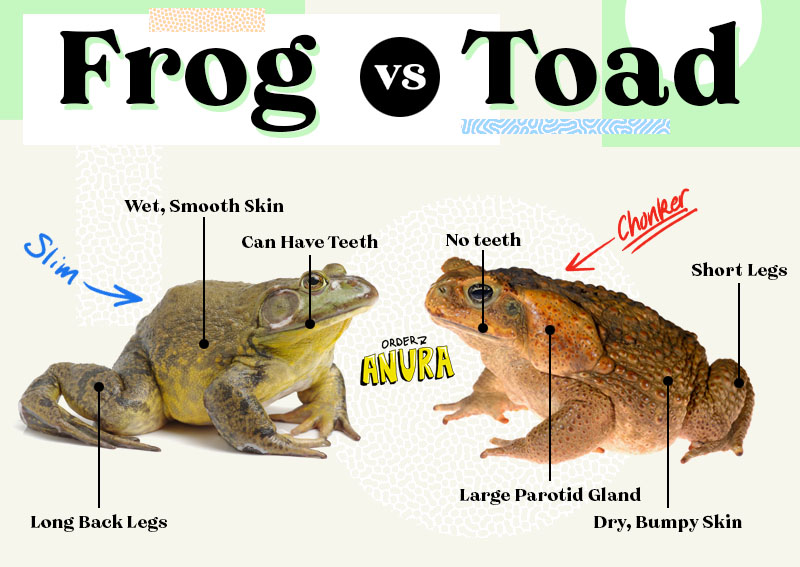
The most asked question in the amphibian world is this: “What is the difference between a frog and a toad?”. It’s a great question, too! One with a complicated answer.
So, what are the differences? From a taxonomic standpoint, there aren’t many differences between frogs and toads. Furthermore, the main differences that stand out are not always unique.
One can say that most toads have short legs, dry skin, they venture far from water, and lay eggs in strings. While that’s mostly true, some toads have smooth, slimy skin: a characteristic usually attributed to frogs.
This article will teach you the difference between frogs and toads, but in order to understand the answer, we first need to define what a frog is and what a toad is.
Table of Contents
Defining Frog and Toad
In order to get a clear definition, we need to know about common names and scientific classifications. Knowing this will help formulate a clear understanding.
Scientific Classification and Common Names
A scientific name or classification refers to taxonomy. You may remember some of the basics from grade school biology: Kingdom, Phylum, Class, Order, and so on…
- Taxonomy is the scientific study of naming and defining biological organisms based on similar characteristics. It’s an organized way of grouping animals together.
- Common Names are informal names. They’re typically easy to pronounce, understand, and remember.
I suspect that most of you are familiar with this process already. In case you’re not, I’ll give you an example. Dogs (domestic dogs) are Canis familiaris. The word “Dog” is a common name for the scientific classification “Canis familiaris“.
So, taxonomy is a way of categorizing and naming animals. Below is a step-by-step process taking you from domain to species. Each one is a taxonomic rank, starting with Domain and ending with Species.
This isn’t a biology class and overcomplicating things is not necessary. However, this brief explanation should suffice in our pursuit to differentiate frogs and toads.
Frog (Order Anura)
Continuing with scientific classification, Frogs are “Anurans”. The word “Frog” is the common name for the scientific classification “Anura”. Anura is an order in the taxonomic rank (see “Order” in the list above).
It’s at this point that our topic starts getting a little confusing but stick with me. Both frogs and toads are within the order Anura. This means, from a taxonomic standpoint, that toads are a type of frog, and calling a toad a frog is acceptable.
For more information on the taxonomic hierarchy of order Anura and its direct children, visit the ITIS database.
Toad (Family Bufonidae)
The word “toad” is (usually) the common name for the Family of Bufonidae. Members of the Bufonidae family are known as “true toads”.
Notice that the Family Bufonidae is within the Order Anura. Toads are frogs because Bufonidae (true toads) are inside the order Anura (frogs).
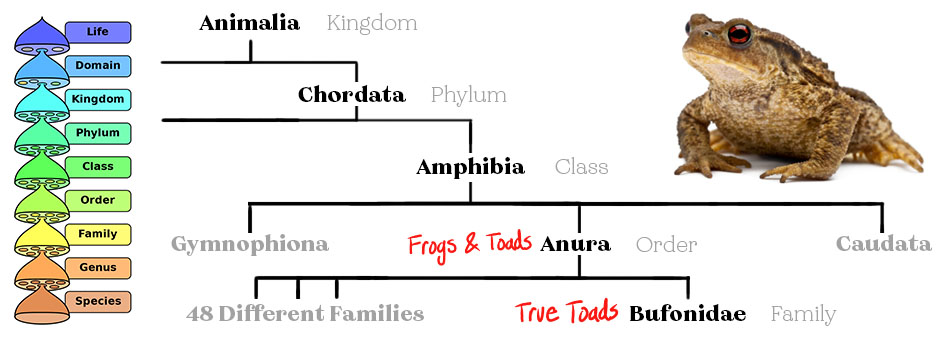
The picture above is a simple illustration showing the taxonomic rank leading up to True Toads.
Answering the Question: What’s the difference between frogs and toads?
Now that we have the word “frog” and “toad” defined, you can see that toads are a type of frog. Not all frogs are toads but all toads are frogs.
The differences in characteristics are minimal and most of them are not unique to one family.
Comparing Frogs and Toads
If today is your first time learning about Anura and Bufonidae, it’s understandable if you’re still confused. Regardless of how you’re doing with all this, we’ve arrived at the section where we’re comparing the differences between frogs and toads.
You’ll soon learn that there are few defining characteristics between true toads and other species in the Anura order. Listed below are some of those differences.
Characteristics: Frogs vs Toads
One of the best ways to compare differences between frogs and toads is by looking at their characteristics. Things like size, shape, skin, locomotion (movement), etc. Let’s get started by looking at their skin…
Skin
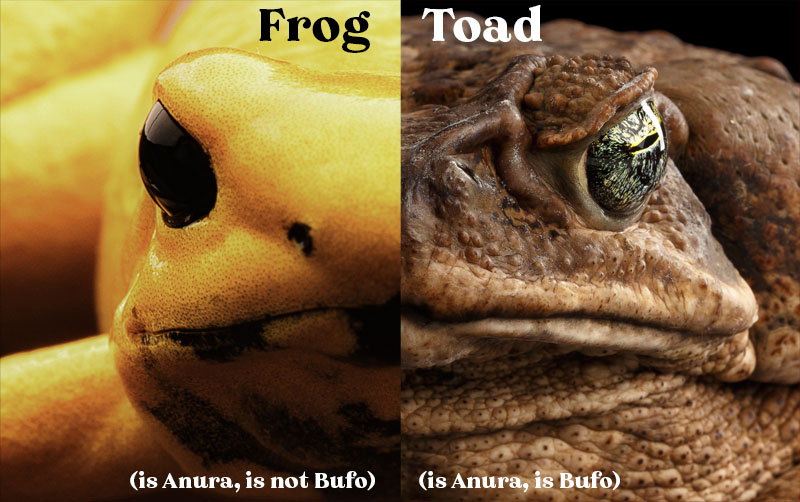
True toads tend to have dry, warty-looking skin. They often have a large parotid gland behind their eyes. The parotid gland contains bufotoxin, which is used as a self-defense mechanism against small predators. Also, many of them have bumps running along their back, spanning from their head to the lower back.
Frogs mostly have smooth, slimy skin. Some species have small bumps along their back but, for the most part, they’re relatively smooth. At first glance, they appear to be wet and slick. Frogs are wet the majority of the time due to their dependency on water but more about this later.
Teeth
True toads do not have teeth[1]. At least not that I can find. Other species of frogs, however, can have teeth. The teeth are maxillary and vomerine teeth. They’re not used in chewing but rather as a means of gripping prey in their mouth as they eat.
Legs
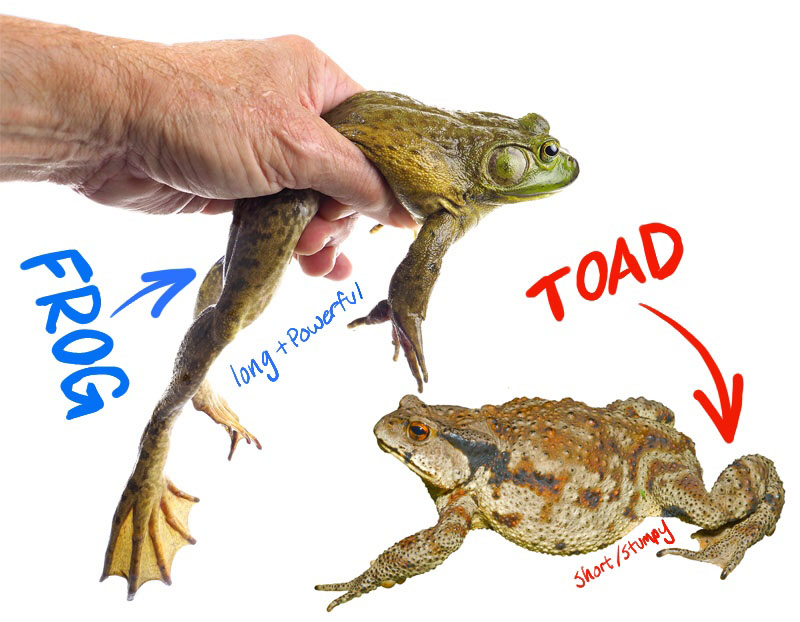
Many of the species in the Bufonidae family have short, squatty legs. They can hop or jump, but not quite like frogs.
Frogs have long, strong back legs. This, in part, allows them to jump great distances. Sometimes over 30x their body length.
Locomotion
Locomotion refers to the way something moves. In the case of animals, it’s how they move from one spot to another. In the case of toads, mostly due to their short, squatty legs, they tend to perform small hops or walk.
Another way to approach this topic is by looking at where they’re found. Toads are mostly terrestrial, meaning they’re land-dwelling. They move around on the ground. You won’t find them on the tops of trees.
The locomotion of frogs is broader. Treefrogs, for example, are considered arboreal. They spend most of their lives above the ground. Not all frogs are arboreal and most are considered semi-aquatic.
Dependency on Water
Perhaps one of the most noticeable differences between frogs and toads is their dependency on water. Both need water but toads are capable of going longer without it. In fact, it’s not uncommon to find toads burrowed into the dirt. They do this in order to ambush their prey and sometimes in order to get hydration from the soil.
Frogs are rarely found far from a body of water. Whether it’s a pond, stream, or large puddle, they won’t wander too far away.
You’re more likely to find a toad hopping through an open field than a frog.
Reproduction & Eggs
Both frog and toad eggs are fertilized externally. But one final area that some toads and frogs differ is specifically how they lay eggs. More specifically, how they lay eggs. Many true toads lay eggs in strings while most frogs lay eggs in clumps[2].
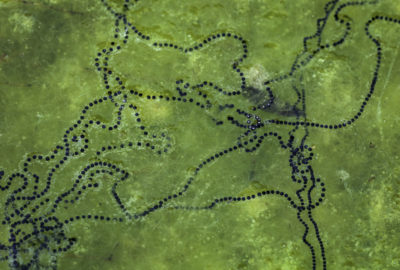
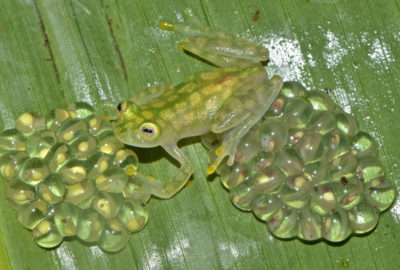
Frogs have many ways of laying eggs and caring for their young. From carrying tadpoles on their backs to creating foam nests. Most, however, lay clumps of eggs.
Frog vs Toad Facts
In this section, I’m going to lay out a few facts regarding frogs vs toads. My hopes are that you’ll obtain a better understanding of the differences and similarities.
True Toads are in the family Bufonidae
I feel we’ve established this fact clearly at this point. It is important, however, to realize that toads are not separate from frogs from a taxonomic standpoint. Toads are a type of frog and there are minimal differences in characteristics.
Some frogs are called toads but they’re not actually toads…
Remember when I explained the difference between a scientific name and a common name? If not, you may want to read that section before reading this.
Well, there are several frogs that have a common name containing “toad” even though they are not within the Bufonidae family.
The Oriental Fire-bellied Toad is a common name for Bombina orientalis. They’re popular among amphibian hobbyists but are naturally found in Korea and parts of China. Despite their common name, Fire-bellied Toads are not true toads [3]. They are not in the Bufonidae family; they are in the Bombinatoridae family.
Moreover, they have bumpy, warty-looking skin which brings us to our next fact…
Some frogs look like toads and vice-versa
Continuing with our last fact, the Oriental fire-bellied “toad” has bumpy skin, which is commonly associated with true toads. This isn’t unique to one species though.
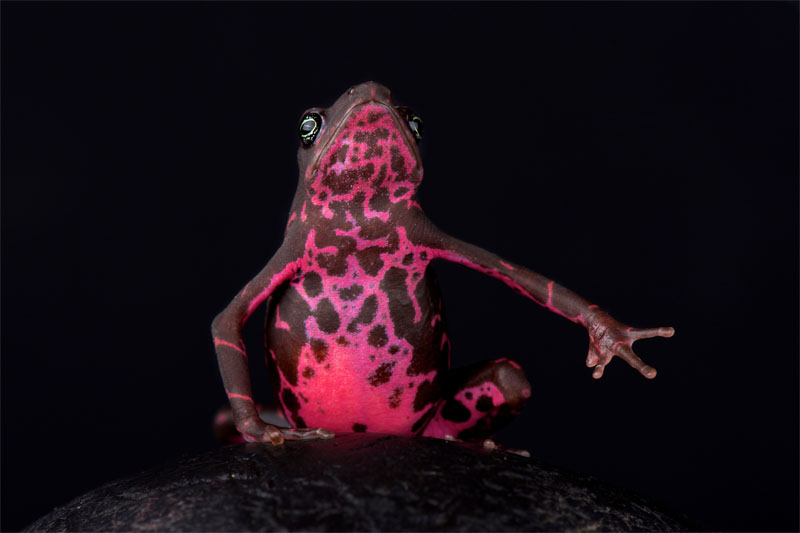
The Purple Harlequin Toad (Atelopus barbotini) is a true toad in the genus Atelopus[4]. At first glance, one might mistake this true toad for a poison-dart frog due to its coloration. Notice how its skin is not bumpy; it’s smooth. Also, as you can see, it has vivid colors which are often associated with poisonous frogs.
This is just one example of many. The defining physical characteristics (bumpy skin, short legs, chubby build, etc) are not unique to toads.
I made a Frog vs Toad Quiz you may be interested in! Each question shows two pictures, one with a True Toad and the other not. It’s your job to pick which one is a toad.
TLDR; Just tell me the difference between frogs and toads!
This topic is challenging to make a summary that provides a clear explanation in a few sentences. I’ll do my best but I encourage you to read the whole post in order to get the best understanding.
Toads are a type of frog. Frogs are every species within the order known as Anura. The order Anura is often referred to as “frogs and toads” because it contains both frogs and toads. Toads or “true toads” are members of the Bufonidae family, which is part of the Anura order.
There are a few characteristics of species in the toad family one can use to compare toads to species of frogs not in the Bufonidae family: Toads often have short legs, bumpy or dry skin, they usually hop or walk, and they don’t have any teeth. Some frogs have teeth and they’re generally more water-dependant than toads.
Despite these characteristics, they’re not all unique to the Bufonidae family. Some frogs have bumpy skin, short legs, etc. Some toads have smooth, colorful skin, long legs, and so on.
From a taxonomic standpoint, there are a few differences between frogs and toads. Simply put, toads are a type of frog…
References
- Toothless Predator | AMNH. (2021). American Museum of Natural History. https://www.amnh.org/exhibitions/frogs-a-chorus-of-colors/featured-frog-species/toothless-predator[↩]
- Hodl, Walter. “Reproductive Diversity in Amazonian Lowland Frogs.” Fortschritte Der Zoologie, vol. 38, 1990. Fortschritte der Zoologie, homepage.univie.ac.at/Walter.Hoedl/Fortschr%20Zoologie%20Reproductive%20diversity.pdf.[↩]
- Yu, Liqun, et al. “Evolutionary History of the Oriental Fire‐bellied Toad ( Bombina Orientalis ) in Northeast China.” Ecology and Evolution, vol. 11, no. 9, 2021, pp. 4232–42. Crossref, https://doi.org/10.1002/ece3.7318.[↩]
- Atelopus.com, Dennis Nilsson. (n.d.). atelopus.com – Atelopus “Guyana Shield” species. Http://Www.Atelopus.Com. http://www.atelopus.com/index.php?page=a-guyanashield[↩]
